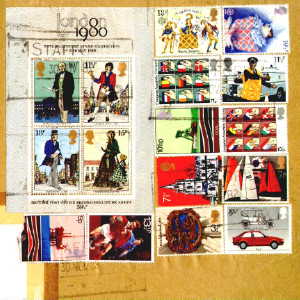| ½p pale blue 1p claret 1 ½p black 2p myrtle green 2 ½p carmine-rose 2 ½p dark pink 3p royal blue 3p magenta 3 ½p olive-grey 3 ½p light violet 4p turquoise-blue 4 1/2 p light blue 5p pale violet-blue 5 ½p brownish violet 6p pale bluish-green 6 ½p greenish-blue | 7p carmine-brown 7 ½p Venetian red 8p red 8 ½p grey-green 9p black/dark orange 9p ultramarine 9 ½p reddish-lilac 10p blackish orange-red & red-orange 10p orange 10 ½p pale cobalt 11p rose-lilac 11 ½p brownish-grey 12p light green 12p emerald green 12 ½p pale bluish-green | 13p olive-grey 13p light orange-brown 13 ½p carmine-brown 14p pale blue-violet 15p royal blue 15 ½p pale blue-violet 16p brownish-grey 20p [Large format] blackish-olive 20p pale grey-violet 25p bright violet 50p [Large format] royal blue 50p grey-brown 75p black £1 [Large format] black £1 [Large format] blackish-olive & pale green-olive. |
All colours are described in terms of the Michel Farbenführer. |
2. Second Class Post 26.Jan.1981 - 31.Jan.1982
|
3. Large or Parcel Covers | |
 |  |
Given a lot of standard definitives or a modest collection of commemoratives, and a lot of space on a parcel or an A4 mailing, the philatelic artist can create a cover which will impress the fortunate recipient and the postman. But this art technique has to be approached with a degree of caution. It is not unknown for particularly splendid creations to disappear into the postal system, especially if they are going abroad, and never reach their destination. Rogue postal employees are not above creating collections of other people's mail. |
| ||
Created for Romiley Arts Federation by HTSP Web Division. © RAF, 2004 |



